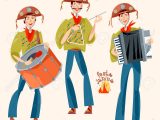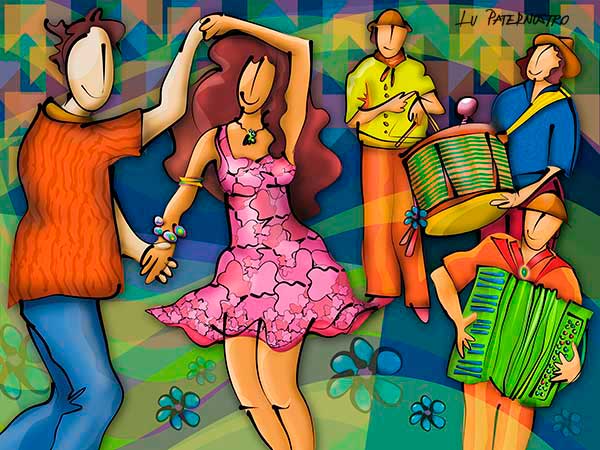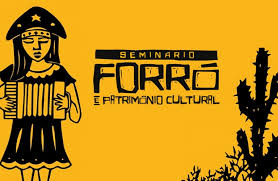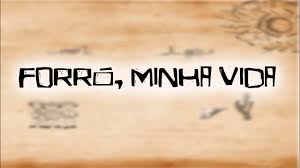Este post também está disponível em:
Português
English

Forró has its origins in the popular dances that were held at the end of the 19th century and were called “forrobodó”, “forrobodança” or “forrobodão”.
At that time it was necessary to wet the floor of the place where these parties took place, because they were made of “beaten floor”, that is, there was no coating, only earth.
People used to dance dragging their feet to avoid the dust rising, hence the term rastapé or arrasta-pé.
Similarities were also found between this style of dance and the toré – an indigenous celebration where, at a given ritualistic moment, individuals drag their feet on the ground.
There is also some influence from Dutch and Portuguese rhythms, as well as European ballroom dances.
Videos about “History, origin and evolution of forró”


História do Forro

Evolução do Forró

Documentário sobre o Forró

A palavra FORRÓ, como surgiu - origem das expressões08:53
The origin of the name forró has some hypotheses:
a. historian and folklorist Câmara Cascudo
The historian and folklorist Câmara Cascudo suggests that the most likely term is a derivation of the term “forrobodó”.
This term, in turn, is a Galician-Portuguese variant of the old word forbodó, which originated from the French word faux-bourdon, which can mean “intonation”.
b. Another assumption – without historical proof
is that the name was created from an English expression.
According to this theory, the British engineers who settled in the Pernambuco region during the installation of the Great Western railway used to hold parties for illustrious figures.
However, at certain times, such events were open to the public and carried in their invitations the term for all, which means “for everyone” in Portuguese. The local people then began to pronounce it “forró”.
c. But it was only in 1950
In the 1950s, the name “forró” began to be used.
For, a year earlier, singer-songwriter Luiz Gonzaga recorded the song “Forró de Mané Vito”, produced together with Zé Dantas. In 1958, another song by the musician called “Forró no Escuro”, was also very successful.
Despite the popularity achieved by the successes of this music icon, what really spread the style throughout Brazil was the northeastern migration to other states of the country, especially in the 1960s and 1970s.
Today, forró is enjoyed throughout Brazil and celebrated on 13 December, the birth date of accordion player Luiz Gonzaga.
Forró as a musical genre
This musical style is popularly associated with other genres: the xote, xaxado and baião. In them, the instrumental base used is the accordion, the triangle and the zabumba.
It is also called traditional forró or forró pé-de-serra and its greatest representatives are Luiz Gonzada, Jackson do Pandeiro, Dominguinhos and Sivuca.
From the 1980s onwards, forró underwent some changes. At that time, drums, guitar and electric bass were also introduced.
In the 1990s, other elements were incorporated by some bands, such as the keyboard and sax, and the zabumba was removed.
This subgenre came to be called electronic or stylised forró and was criticised for turning traditional forró into a superficial product of the cultural industry.
In the 2000s, this type of music was given a new makeover and emerged in the form of forró universitário, which added some instrumental changes to the original style.
Forró as dance
The forró is danced in pairs in a closed embrace position, with the partners facing each other, using full or partial body contact.
Depending on the style of music played – baião, xote, xaxado, university forró or electronic – the way of dancing is also altered.
The main destinations for those who enjoy dancing forró are: Itaúnas (ES), Caruaru (PE) and Campina Grande (PB).

Main representatives of forró are Luiz Gonzaga, Carmélia Alves, Dominguinhos, Trio Nordestino, Jackson do Pandeiro, Sivuca, Alceu Valença, Elba Ramalho, Geraldo Azevedo, Falamansa, Rastapé, Forroçacana, Mastruz com Leite, Calcinha Preta, Frank Aguiar and Aviões do Forró. She has had three major phases in her career.
Style has gone through three major phases since it emerged in the 1940s.
Evolution causes dispute, but formats can coexist, say critics.
The main moment of the forró marathon at São João festivals in the Northeast begins this week.
As the official night of the saint’s celebration approaches, next Friday (24), it is almost impossible to hear any different music at this time in the cities that become the main focus of the party, such as Campina Grande (PB) and Caruaru (PE).
But saying that everyone plays forró doesn’t necessarily mean that the music is the same.
Over the seven decades since it emerged and spread through the hands of Luiz Gonzaga, the musical style that is a symbol of the Northeast has undergone transformations in its form.
Luiz Gonzaga is no longer a purely regional music played with accordion, zabumba and triangle, but has adapted to modernity, incorporating elements of pop, axé and technobrega.
Newer forró bands have a production comparable to big pop shows in the world.
One such group, Calcinha Preta, has even performed 360-degree shows, like those of U2.
The transformation of forró generates controversy and disputes.
Paraíba’s culture secretary, singer Chico César, has criticised the more “modern” bands, which he called “plastic forró”.
In the same vein, Dominguinhos, faithful to the original forró, has already claimed that the new bands have changed the style so much that “you can’t say that’s forró”.
Despite the evolution of forró and the contrasts, the different styles of forró can “coexist”, according to Expedito Leandro Silva, author of “Forró no Asfalto: mercado e identidade cultural”, in which he deals with the evolution and urbanisation of the musical style that is a hallmark of São João in the Northeast. “The former does not cease to exist, and the latter continues to modernise and accentuate its differences from the original.”
Forró style is divided into three major phases:
Traditional Forró (also called pé-de-serra),University Forró and Electronic Forró
They are marked by urbanisation, technical incrementation and adaptation of the style to the market at different times.

Emergence of Forró
As soon as it appeared, forró was an authentic artistic creation of the rural universe of the sertanejo, and had in Luiz Gonzaga its main promoter and representative.
The music was usually played with only three instruments and featured nostalgic, regional themes and a strong country accent in its lyrics.
Forró pé-de-serra is still present in its classic form in the great festivities of the Northeast.
Whether by the hands of nationally recognised artists such as Dominguinhos, or by more local names such as Santana, there are still those who keep the original style alive.
Recycling Forró
The first major changes came in 1975, when popular musicians of the time, such as Alceu Valença, Zé and Elba Ramalho and Geraldo Azevedo took up forró, adapting the style to the time and the way they already played. It was forró Universitário, named after the young, urban audience they appealed to.
The style was taken up again in a similar vein two decades later, when groups like Falamansa and Trio Rastapé became nationally popular with “forró pé-de-serra adapted to today’s world”, as Falamansa’s Ricardo Cruz explained.
“The similarity between us and Alceu Valença and Zé Ramalho exists because we have followed the same movement of searching in the original, traditional sources, such as Luiz Gonzaga and Jackson do Pandeiro, combining it with the moment we live in.
In my case, it is the contemporaneity, mixing the “pé-de-serra” with influences of reggae, rock and MPB. We seek to make pé-de-serra together with our daily lives, our reality,” he said.
Forró Revolution
Despite the continuity of traditional forró and the change of accent without much transformation of the university, in the 1990s the style underwent its greatest transformation.
This was when forró incorporated new instruments, dancers, more colourful clothing and elements of country, romantic, brega and even axé music to create electronic forró.
Also called stylised forró or even “oxente music”, the movement started at the beginning of the decade, with groups like Mastruz com Leite and Magníficos, and has become bigger and more transformative over the years.
The change in recent decades has been so intense, reaching groups like Aviões do Forró and Calcinha Preta, which, according to researcher Expedito Silva, have changed the original proposal so much that they are closer to technobrega than to forró itself.
The founder of the band Magníficos, one of the first of the stylised forró, explained that what they do is romantic popular music mixed with forró. “It’s as if we took a song by Roberto Carlos, for example, and played it in forró rhythm,” said José Inácio, Jotinha.
The Magníficos band actually started out with traditional, pé-de-serra songs, but decided to change. “Luiz Gonzaga influenced us a lot, but we adapted the traditional pé-de-serra to the romantic one. We like it and respect it, but it’s not what we want to do. You have to follow the evolution of things,” he said.
According to Silva, who has studied the evolution of forró, the main difference between the classic style and the electronic one is that the new bands deal better with the market, they sell more. “The style is preferred by younger people, who identify more.
What happens is that those who like forró, especially in the Northeast, do not confuse electronic with traditional. He sees the stylised as leisure, fun, pastime, but respects the traditional forró,” he said.
See also Origins and the evolution of forró at São João parties
History, origins and evolution of forró in the north-east
Tourism and travel guide to Bahia and the Northeast



















